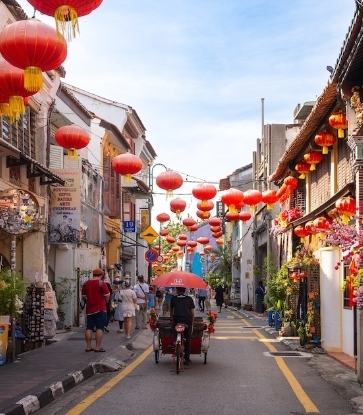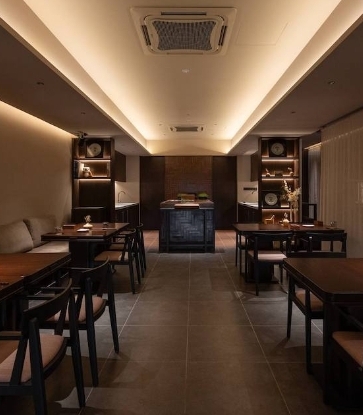Kway teow is the well-loved flat rice noodles of the Teochew people. The Teochews, who originated from the cities of Chaozhou and Shantou (collectively known as Chaoshan) in Guangdong, China, were prolific emigrants of Southeast Asia in the 19th- and early-20th century. They became the dominant Chinese dialect group in Bangkok and parts of Indochina. They are also known as Chiuchow in Hong Kong, Taechiu in Thailand, and Triều Châu in Vietnam.
In Penang, Malaysia — where the Hokkiens form the majority of the Chinese populace, the Teochews traditionally dominate the street food trade, and many well-known Penang street foods are Teochew in origin: Char Kuey Teow, Kuey Teow Th’ng, Char Kway Kak, Kway Chap, and more.
In Singapore, the Teochews constitute the second-largest Chinese community after the Hokkiens, and Teochew culinary culture has a significant influence on many aspects of Singaporean-Chinese cuisine. For example, one of the city-state’s top Chinese restaurants is MICHELIN-Starred Imperial Treasure Fine Teochew Cuisine (Orchard), where this culinary culture is exemplified in the restaurant's dishes.
Wherever the Teochews go, the kway teow will surely follow. In Southern Vietnam, one of the best-loved noodle dishes is hủ tiếu Nam Vang, meaning "kway teow from Phnom Penh”, so-called as the dish was introduced by itinerant Teochew noodle vendors who’d first settled in Cambodia, then crossed over to Vietnam in the 1960s. The Cambodians call their noodle kuyteav, which, like the Vietnamese hủ tiếu, are derived from the Teochew word, kway teow.
The same noodles also form the basis for Northern Vietnam’s pho, where the noodles are steeped in a deep-flavoured broth, much-loved by many — both locally in Vietnam and also abroad, especially in the West, where there is a large Vietnamese diaspora.
In pre-World War II Thailand, the invention of the Pad Thai was attributed to Prime Minister Plaek Phibunsongkhram, who had wanted to promote Thai nationalism through “a noodle dish than they could call their own”, rather than consume Chinese-style fried noodles. And it was the kway teow noodle formed the basis for Pad Thai.
With that said, here are some well-known dishes where the versatile kway teow is utilised:

Kway Teow Th’ng
Flat rice noodles served in a clear and savoury soupOne of the best loved hawker foods in Penang is the Kway Teow Th’ng — flat rice noodles in a savoury broth, garnished with fishballs, slices of fish cake, and a choice of minced pork, slivered chicken, or duck. In Singapore, an additional garnish is her giao (Teochew fish dumplings).
The Kway Teow Th’ng broth is a high-wire act, pivoted upon the savouriness of pork bones, whole chickens, and ducks on one side; and the subtle sweetness from rock sugar on the other, with condiments and aromatics like pork lard, golden-fried lardons, garlic oil, and crisp-fried garlic crumbs thrown in to add extra layers of flavour.
The Penang Kway Teow Th’ng has the same taste profile as the Vietnamese Hủ Tiếu Nam Vang and the Cambodian Kuyteav, with the Vietnamese version being noticeably sweeter, whilst the Cambodian rendition is the sweetest.
Kway Teow Th’ng in Singapore has a lighter, subtler broth, and emphasised more upon the fishball and fishcake garnishes; whereas their Penang cousins tend to be more meat-heavy, with slivered duck or chicken meat added, besides pork slivers or minced pork patties.
Where to enjoy Kway Teow Th’ng in Kuala Lumpur & Penang:
Ah Boy Koay Teow Th’ng (Bib Gourmand, MICHELIN Guide Kuala Lumpur & Penang 2024)
Fook Cheow Café (Selected Restaurant, MICHELIN Guide Kuala Lumpur & Penang 2024)
Pitt Street Koay Teow Soup (Selected Restaurant, MICHELIN Guide Kuala Lumpur & Penang 2024)
Where to enjoy Kway Teow Th’ng in Singapore:
Hup Kee Teochew Fishball Noodles (Selected Restaurant, MICHELIN Guide Singapore 2023)
Lao Shen Ji Si Mian (Selected Restaurant, MICHELIN Guide Singapore 2023)
Shanyuan Teochew Kway Teow Mian (Selected Restaurant, MICHELIN Guide Singapore 2023)

Char Kway Teow
Stir-fried flat rice noodlesPenang’s signature Char Kway Teow bore little resemblance to the original renditions back in Chaoshan, the Teochew homeland. Whilst fried kway teow in Chaoshan consists of flat rice noodles fried with pork, leafy green vegetables, and salted radish (called ”chai por” in Teochew), the Penang version sees the Teochews adding everything they missed from their homeland as they settled as new emigrants in Penang: prawns, cockles, Chinese sausages, chives, duck’s egg, beansprouts, sliced fishcakes, and more. So, one could say that the origin of Penang Char Kway Teow is really the story of how a creation, borne out of homesickness, became the ubiquitous and very popular dish that we know today.
The seasoning mainly consists of fish sauce, which is indispensable to Teochew cooks: light soy sauce, dark soy sauce, rock sugar, and other condiments. Singapore Char Kway Teow, on the other hand, shows more Hokkien influences: like the introduction of yellow Hokkien wheat noodles to mix with the kway teow, the addition of sweet caramel sauce, plus the heavier use of thick, dark soy sauce. Hokkiens prefer their noodles intensively flavoured, and gluggier, with a bit of gravy.
Where to enjoy Char Kway Teow in Kuala Lumpur & Penang:
Ming Qing Charcoal Duck Egg Char Koay Teow (Bib Gourmand, MICHELIN Guide Kuala Lumpur & Penang 2024)
Penang Road Famous Jin Kor Char Kuey Teow (Bib Gourmand, MICHELIN Guide Kuala Lumpur & Penang 2024)
Siam Road Char Koay Teow (Bib Gourmand, MICHELIN Guide Kuala Lumpur & Penang 2024)
Where to enjoy Char Kway Teow in Singapore:
Lao Fu Zi Fried Kway Teow (Bib Gourmand, MICHELIN Guide Singapore 2023)
Outram Park Fried Kway Teow Mee (Bib Gourmand, MICHELIN Guide Singapore 2023)
No.18 Zion Road Fried Kway Teow (Bib Gourmand, MICHELIN Guide Singapore 2023)
Hill Street Fried Kway Teow (Selected Restaurant, MICHELIN Guide Singapore 2023)
91 Fried Kway Teow Mee (Selected Restaurant, MICHELIN Guide Singapore 2023)

Pho
Light Vietnamese soup with rice noodlesPerhaps Vietnam’s best-known culinary export to the world, Pho consists of thin kway teow-like rice noodles called banh pho, in a fortifying, deep-flavoured beef broth, garnished with thin slivers of beef, accompanied by fresh, leafy herbs on the side.
The origin of Pho has been attributed to the French, via their predilection for beef consumption compared to the Vietnamese, as well as the possibility that pot-au-feu, the French national dish of beef and vegetable stew, may have been the inspiration for the Pho. The Vietnamese went one step further: introducing flat rice noodles to the dish to bolster the content.
Although the Northern Vietnamese were the creators of Pho at the cusp of the 19th- and 20th-century, the version better-known to the world was brought by South Vietnamese refugees to the West, post-Vietnam War. In contrast to the austere North Vietnamese version that features noodles in beef broth, the Southern version also includes fresh herbs and vegetable garnishes
Where to enjoy Pho in Kuala Lumpur & Penang:
Sao Nam (Bib Gourmand, MICHELIN Guide Kuala Lumpur & Penang 2024)

Beef Kway Teow
Stir-fried flat rice noodles with beef, usually served with a thick sauceLorong 9’s style of Beef Kway Teow in Singapore is closer to Cantonese Gon Chao Ngow Hor (乾炒牛河), rather than the Teochew soup version sold at Hock Lam Street which dates back to 1921, or the Hainanese version popularised post-World War II at the Odeon cinema on North Bridge Road.
Here, the noodles are wok-seared, and then smothered in an unctuous gravy, flavoured with fermented bean paste, soy sauce, and chillies, containing tender beef slices and scallions.
Where to enjoy Beef Kway Teow in Singapore:
Lor 9 Beef Kway Teow (Selected Restaurant, MICHELIN Guide Singapore 2023)

















